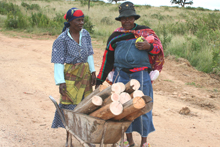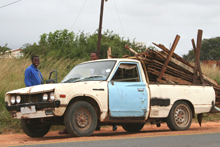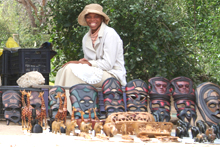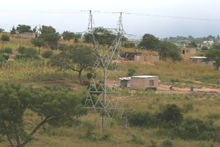SUNRAE AND SAEON – Joining forces for a sustainable future
|
An accession agreement soon to be signed between SAEON and the University of the Witwatersrand (Wits), has its roots in an environmentally significant research programme conducted at the Wits Rural Facility in the central lowveld region of Limpopo Province, close to the Kruger National Park, an area that falls within the UNESCO Kruger to Canyons Biosphere Reserve.
The central lowveld is characterised by dense rural populations of the former black homelands created during South Africa's apartheid past, juxtaposed with exclusive private game reserves and state conservation areas, all within a semi-arid savanna environment. Hence the link to SAEON's Ndlovu Node which operates in the savanna biome and is hosted by the Kruger National Park.
This research programme for the Centre of African Ecology resides in the School of Animal, Plant and Environmental Sciences at Wits and is known as SUNRAE (Sustaining Natural Resources for the African Environment). Dr Wayne Twine, programme manager and full-time researcher, is assisted by two part-time staff members - a community liaison officer, Siyabulela Morris, and an administrator, Vivian Khubayi.
With its focus on understanding human/environment interactions in the former homeland areas, the programme is mainly concerned with the ecological basis for sustainable rural livelihoods and development, with special emphasis on the role played by the natural environment in rural livelihoods, the uses of indigenous plant resources and consequences of land use change for biodiversity.
The aim of the programme is to generate information, knowledge and expertise on an ecological basis for sustainable rural development. The whole rural society is a society in rapid transition from more traditional to more modern. And part of that is reflected in the diet and the way people rely on the natural environment.
|
"Other work that we do is to quantify the limits to sustainability," says Wayne, "in other words, quantifying the actual consumption of resources and their regeneration and local supply, and looking at what the limits to sustainable harvesting are." Wayne is passionate about promoting research and postgraduate student training in ecology and allied disciplines within the context of rural development, and the sharing of the knowledge and skills gained towards the improved sustainability of rural livelihoods and the biological resource base in southern Africa.
Despite resources being spread thinly, the programme has made giant strides in longitudinal research into sustainable rural livelihoods and development, adding considerably to our knowledge about the impact of rural communities on natural resources. A large part of the programme's research is done by postgraduate students, under Wayne's direction and supervision.
One of these students has just completed a comparative study on the use of edible wild herbs and the types of species that are used, based on similar data sets collected over a period of 10 years by Wayne's predecessor at the programme, Charlie Shackleton. The study indicated considerable change in the patterns of use – even within one generation.
Wild herbs are also used as medication. It forms part of the treatment that local traditional healers use. "We know that some of these plants have immune-boosting properties, and are effective in the treatment of secondary infections associated with HIV/AIDS," says Wayne.
Although most households have a small vegetable garden, just about no households in the area can really be regarded as subsistence households. "That kind of livelihood strategy really does not exist in South Africa anymore," explains Wayne, "partly because of our history of forced removals and high densities of people in the former homelands and just not enough land. People have also been locked into a cash-based society a lot longer, starting with the gold mines in the late 1800s. So people don't pursue purely agrarian livelihoods."
Agriculture with its crops and livestock just forms part of what are quite complex livelihood strategies. So most households, even if they have fields and cattle, still buy some of their food. And if the breadwinner passes away, one of the coping strategies for families is to increase their intake of wild foods.
|
Natural resources also help households to save money. Even in villages where every household has access to electricity, over 90% of households use fuel-wood for cooking even though they use electricity for lighting. The reason is that the electricity that a light consumes is negligible, but a stove uses much more electricity. In addition, electrical appliances are expensive items to buy.
So, in the context of poverty, the use of natural resources buffers the household against poverty."If they don't have access to fuel-wood, they have to pay for electricity and they have to buy a stove and that's money that gets diverted away from things such as school fees and uniforms," says Wayne.
The programme has also done significant work in terms of quantifying the actual value of the natural resources that are used. As Wayne explains: "We've done work that has quantified the direct use value. If you know how many kilograms of fuel-wood a household uses per month, and you extrapolate that to annual consumption, and you know at what price wood is being sold for in the village (a bakkie load fetches about R180), and you determine the weight of that load of wood, you can work out a local price per kilogram of fuel-wood. If a standard household is using an average of x kilograms, you multiply that by the price. In this area the average household is probably using the equivalent of about R2 000's worth of fuel-wood per annum. That's not necessarily what they're paying, but that's what they would pay for that wood if they had to buy it. And that can then be costed against what they would have been paying for electricity and appliances to cook their meals. Even if they bought all their wood it would still be cheaper than buying a stove and using electricity."
To determine the impact of consumption, the programme looks at supply and demand. Demand is quantified by determining, on average, what percentage of households use fuel-wood in the village, and what the average per capita consumption amounts to. The resource base is quantified by determining what the current standing density of stems and the growth rate of trees in savannas are to determine the regeneration rate (Wayne's predecessor gathered useful information on that aspect over the years).
|
An important aspect that a master's student has researched under Wayne's supervision, is the coppicing rate of trees, and the opportunities for sustainable fuel-wood harvesting based on the rotational harvesting of coppice.
SUNRAE and SAEON
"I work very closely with SAEON - I was part of the team that helped draft the Ndlovu Node/ SAEON proposal and I was on the panel that conducted the interviews for the Node manager and appointed Dr Dave Balfour," says Wayne.
Dave Balfour of the SAEON Ndlovu Node initiated a transparent process for deciding where the core research sites of the Node should be, and Wits has been involved in this process. Wayne will also be serving on a reference group/steering committee for the Node, and exploring the synergies of data sharing.
"I've been mandated by Wits to represent the university as a member of the consortium in Ndlovu Node," says Wayne. His liaison with the SAEON Ndlovu Node staff would be in two capacities: The Wits link – to develop and explore ways in which Wits could benefit SAEON and SAEON could benefit Wits, but also in his capacity as a researcher doing long-term research on the human/environment interface.
Synergies between SUNRAE and SAEON include a strong focus on research, student training, and education outreach. Shared objectives are:
- to conduct applied research around the issues of sustainable utilisation and management of indigenous resources applicable to Africa's semi-arid regions
- to develop human resources in the form of university graduates with appropriate awareness and expertise
- to understand and address resource conservation issues in the context of rural development
- to synthesise and disseminate information and understanding to rural communities; local, provincial and national government agencies, landowners, development planners, policy makers and the scientific community
- to play a catalytic role in the integration of knowledge and expertise across various disciplines concerned with the sustainable use of non-arable land and its resources for rural economic upliftment.
"SUNRAE has successfully forged relationships with local rural communities, local, provincial and national government agencies, local landowners, non-government organisations, and other academic and research programmes and institutions," says Wayne. "Through these partnerships and networks, we are able to collaborate with SAEON in research and share research findings."
"Obviously the SAEON Ndlovu Node is in its very early stages, and so our emerging roles will become clearer. We're all still grappling with exactly how SAEON will function. We understand the concepts, but what exactly will SAEON do and how exactly will my research and other Wits research link into SAEON and how will SAEON benefit us? We understand it conceptually, but as it becomes clearer by doing, our actual roles and our interaction with SAEON will become clearer and probably more intensive."
In terms of liaison with other emerging SAEON nodes, Wayne says that their priority would obviously be where Wits has a consolidated long-term presence, such as at the rural facility in Limpopo Province where he works. The facility represents a long-term presence in the area with its environment/human-based research.
"Here we're clearly a stakeholder because the university has a big research presence and infrastructure in this area," explains Wayne. "This represents a long-term commitment to longitudinal research." Wayne's research focuses primarily on the savanna biome, which forms a logical link to SAEON's savanna node and activities within the savanna node.
Collaboration with other Wits facilities and projects
Although Wits has research sites elsewhere in the country that may link to certain of the nodes, these don't have the same kind of physical infrastructure as the rural facility. But Wayne foresees that there would certainly be departments and individual research specialists who work in areas like coastal or fynbos that would want to become involved with SAEON.
One example is a GIS expert on the main Wits campus who is working with both Wayne and the Ndlovu Node staff. Currently they're looking at long-term monitoring of land cover change. "Obviously as part of the SAEON network we'll be happy to share our research findings and our experiences," says Wayne. "At the 21 villages where we're doing long-term research we look at how land cover changes and how the population changes."
The project Wayne manages is just one of many Wits research projects that operate out of the rural facility. His project focuses mainly on ecological issues. For his AIDS-related research project, he has established a productive research partnership with the Wits-MRC Agincourt Health and Population Unit, which does very detailed, long-term health and population research.
They conduct an annual census in about 11 000 households in the Agincourt Demographic Surveillance site in southern Bushbuckridge, and their longitudinal health and population research project forms the backbone for many other studies in the area. They now have 14 years of data. Wayne's research on the impacts of HIV mortality on household resource use would not have been possible without collaborating with the Agincourt Unit.
"SUNRAE is an official research partner of that specific Wits unit, and they are also interested in SAEON and exploring possible synergies with SAEON. I guess their main link to SAEON would be via my collaboration with them at the human population interface. But they have long-term human data, which one can link to long-term ecological data."
Into the future
Wayne sees the further development and expansion of the research theme around HIV/AIDS and livelihoods and natural resources as an important future initiative. "There is a need for more data on that," he explains. The HIV/AIDS research theme forms part of a broader research theme that they're developing – the current and potential role of the natural environment in poverty alleviation and rural development.
|
"Wits University will obviously continue to conduct longitudinal research on various aspects of health and populations to help us understand the society that's in transition, rapid transition, and what the implications of that are for development," says Wayne.
"We're certainly at a phase where we are ready to forge stronger links with government, and to look at joint interventions. We as a university can't take primary responsibility for interventions, whether environmental or health, but we are at a stage where our research projects are mature enough and have enough data to be able to link with government and NGO partners to explore interventions. The role of the Wits Rural Facility would be to provide the information, and monitoring capacity," he explains.
Current links with government are at different levels for different research projects and programmes. For the health programmes collaboration is quite advanced on local (municipalities), provincial, and national government levels.
For Wayne's programme, collaboration is still strongly local, at the level of villages, traditional authorities, community development forums, and local government (municipality). But they have started working on provincial level as well. "We have some linkages with the local Limpopo Conservation Offices here, and also with Mpumalanga Conservation, but we're increasingly linking with national government because that's where a lot of the policy implications need to be communicated."
The next link would be to SAEON – first of all to consolidate the longitudinal data within the SAEON framework and to involve SAEON and other SAEON partners in the planning of future longitudinal research, so that longitudinal projects are not developed without serious thought as to how that would plug into SAEON into the future.
Wayne also sees synergies with SAEON in terms of strategies of monitoring, as well as government and other types of implementation. Longitudinal monitoring type of data will become increasingly important into the future, as will links with government on all levels, but on national level in particular to inform decision-making. "SAEON and Wits will do well to share their experiences, and our partners would by default I guess become SAEON partners in that kind of work," he predicts.
"For this next research project where we'll be exploring the impact of AIDS on food security and how households use natural resources, the national Department of Water Affairs and Forestry (DWAF) is an official partner in the project," says Wayne. "And their role there is to help us link our research findings to policy. I don't think scientists are particularly good at knowing how to make their information useful to policy makers, who to target, and how to communicate it."
Wayne is concerned about the fact that at a policy level all one hears about is AIDS treatment. "These are important issues clearly, but the environment isn't on peoples' radar screen when it comes to AIDS. And not only in South Africa, but internationally. So the contribution we make to this sort of global scientific debate I see as being important."
According to Wayne the role of the environment in poverty alleviation and mitigating the impacts of AIDS is an issue that gets underreported on globally. Wayne and his colleagues became increasingly aware of how pertinent this research was when they started to collect literature for their original research proposal.
"Everyone would keep saying that clearly the links between AIDS and the environment are important, whether it's what the impact of AIDS would be on the environment or the role of the environment in mitigating the effect of AIDS," says Wayne. But when they tried to find studies with data, it was all based on assumption. Hence they feel that their research is making a really important contribution, nationally and internationally.
Up into Africa in partnership with SAEON
Wayne would like to explore the possibilities of linking up with ELTOSA via SAEON to share ideas with other role players up into Africa.
"I definitely think that we have a role to play here, because the lessons we are now learning can be shared with our partners elsewhere in Africa. And sharing ideas on this kind of longitudinal research and on this type of livelihoods-based research elsewhere within ELTOSA nodes would provide very useful comparative studies, because the impact of AIDS is not necessarily the same, and the state of the AIDS epidemic is different in different countries and different parts of the countries.
"I think ELTOSA can provide a network for setting up this kind of research partnerships so that we can have a number of comparative studies to help one understand what is happening at a regional level," says Wayne.















